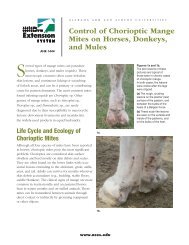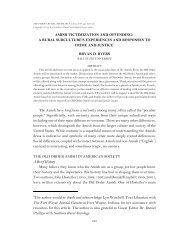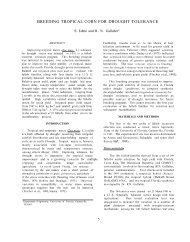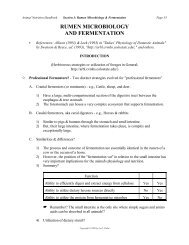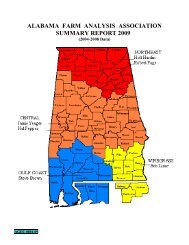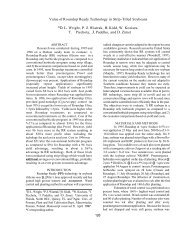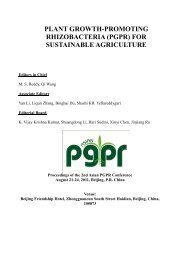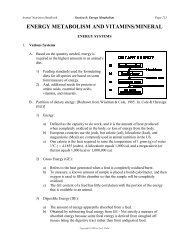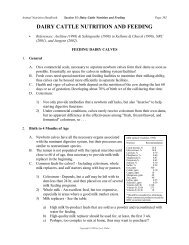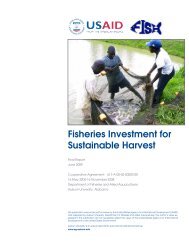- Page 1 and 2: LEWIS SMITH LAKE Phase I Diagnostic
- Page 3 and 4: EXECUTIVE SUMMARY
- Page 5 and 6: January 1986 (Bayne et al. 1987). T
- Page 7 and 8: Total alkalinity, the concentration
- Page 9: found at concentrations ranging fro
- Page 19 and 20: Table 1-1. Table 1-2. Table 2-1. Ta
- Page 21 and 22: List ofTables (Continued) Table 10-
- Page 23 and 24: List ofTables (Continued) Table 10-
- Page 25 and 26: LIST OF FIGURES Figure 8-I. Locatio
- Page 27 and 28: PARTI. DIAGNOSTIC STIJDY 1
- Page 29 and 30: Table I-I. Morphometric characteris
- Page 31 and 32: 2.0 BASIN GEOLOGY AND DRAINAGE Smit
- Page 33 and 34: Table 2-1 (Cont'd) Suitability/Limi
- Page 35 and 36: 4.0 SIZE AND ECONOMIC STRUCTIJRE OF
- Page 37 and 38: - U. II Table 4-2. Number ofbusines
- Page 39 and 40: I, Table 4-4. Agricultural producti
- Page 42 and 43: 7.0 LAKE USE COMPARISON WIlli NEARB
- Page 44 and 45: 00 Table 8-1. Actual point source l
- Page 46 and 47: N 0 Table 8-1 (Continued) Actual To
- Page 48 and 49: N N Table 8-1 (Continued) Actual To
- Page 50 and 51: Table 8-1 (Continued) Actual Total
- Page 52 and 53: tv 0- Table 8-2 (Continued) Permitt
- Page 54 and 55: Annual point source total suspended
- Page 56 and 57: Table 9-1. Location oftributary sam
- Page 58: nitrogen, nitrite-nitrogen, total a
- Page 68:
highly positively correlated (p < 0
- Page 71 and 72:
(31.4% and 30.5%, respectively). Ro
- Page 73:
In 1985, the paucity ofinfonnation
- Page 76 and 77:
population of 1.15 million. In addi
- Page 78 and 79:
V> tv Table 10-1. Schedule of activ
- Page 80 and 81:
..,. en IN o 2 4 i Miles Figure 10-
- Page 82 and 83:
sample were poured into Nalgene"' c
- Page 84:
flows encountered in 1995,428 days.
- Page 87 and 88:
Table 10-6. Mean (range) temperatur
- Page 89:
Table 10-8. Mean (range) temperatur
- Page 94 and 95:
Examination oftemperature, DO and s
- Page 96 and 97:
Table 10-10. Mean (range) turbidity
- Page 98 and 99:
Table 10-12. Mean (range) turbidity
- Page 100 and 101:
Table 10-14. Mean (range) Secchi di
- Page 102 and 103:
Table 10-16. Mean (range) Secchi di
- Page 105 and 106:
a low of 7 mgIL to a high of67 mgIL
- Page 107 and 108:
Table 10-18. Mean (range) pH, total
- Page 109 and 110:
Table 10-20. Mean (range) pH, total
- Page 111 and 112:
Table 10·21. Ammonia, nitrite, nit
- Page 113 and 114:
Table 10-23. Mean (range) ammonia,
- Page 115 and 116:
in concert with changes in algal bi
- Page 117 and 118:
Table 10-25. Orthophosphate and tot
- Page 119 and 120:
Table 10-27. Mean (range) orthophos
- Page 121 and 122:
stratification (Fig. 10-2). During
- Page 123:
Table 10-30. Chloride, total organi
- Page 126 and 127:
Table 10-33. Mean (range) chloride,
- Page 128 and 129:
In August 1986, iron and manganese
- Page 130 and 131:
1971). Productivity measured during
- Page 132 and 133:
Table 10-36. Mean (range) phytoplan
- Page 134:
Table 10-38. Mean (range) phytoplan
- Page 139:
Table 10-39. Phytoplankton taxa by
- Page 145:
(station 2) in the winter to a high
- Page 149 and 150:
Table 10-41. Mean (range) phytoplan
- Page 151 and 152:
Table 10-42. Mean maximum dry weigh
- Page 153 and 154:
Table 10-43. Temporal and spatial v
- Page 155 and 156:
11.0 BIOLOGICAL RESOURCES 11.1 Fish
- Page 157 and 158:
Table 11-1. Total number, catch per
- Page 159 and 160:
Table \\-3. Ranking by quality indi
- Page 161 and 162:
Table 11-5. Checklist of fish speci
- Page 163 and 164:
Table 11-5 (Continued) Scientific N
- Page 165:
11.2 WILDLIFE A checklist ofbirds,
- Page 169 and 170:
Table 11-7 (Continued) Family Scien
- Page 171 and 172:
Table 11-7 (Continued) Family Scien
- Page 174:
Table 11-7 (Continued) Family Scien
- Page 177 and 178:
Table 11-7 (Continued) Family Scien
- Page 179 and 180:
Table 11-7 (Continued) Family Scien
- Page 181 and 182:
PART II. FEASffiILITY STUDY 154
- Page 183 and 184:
from Atlanta, Georgia received an a
- Page 185 and 186:
An additional source ofnutrients to
- Page 187 and 188:
Indirectly, low pH can result in hi
- Page 189 and 190:
13. Are there additional feasible a
- Page 191 and 192:
Bayne, D. R., W. C. Seesock, P. P.
- Page 193:
Taylor, W.D., S.c. Hem, L.R. Willia



